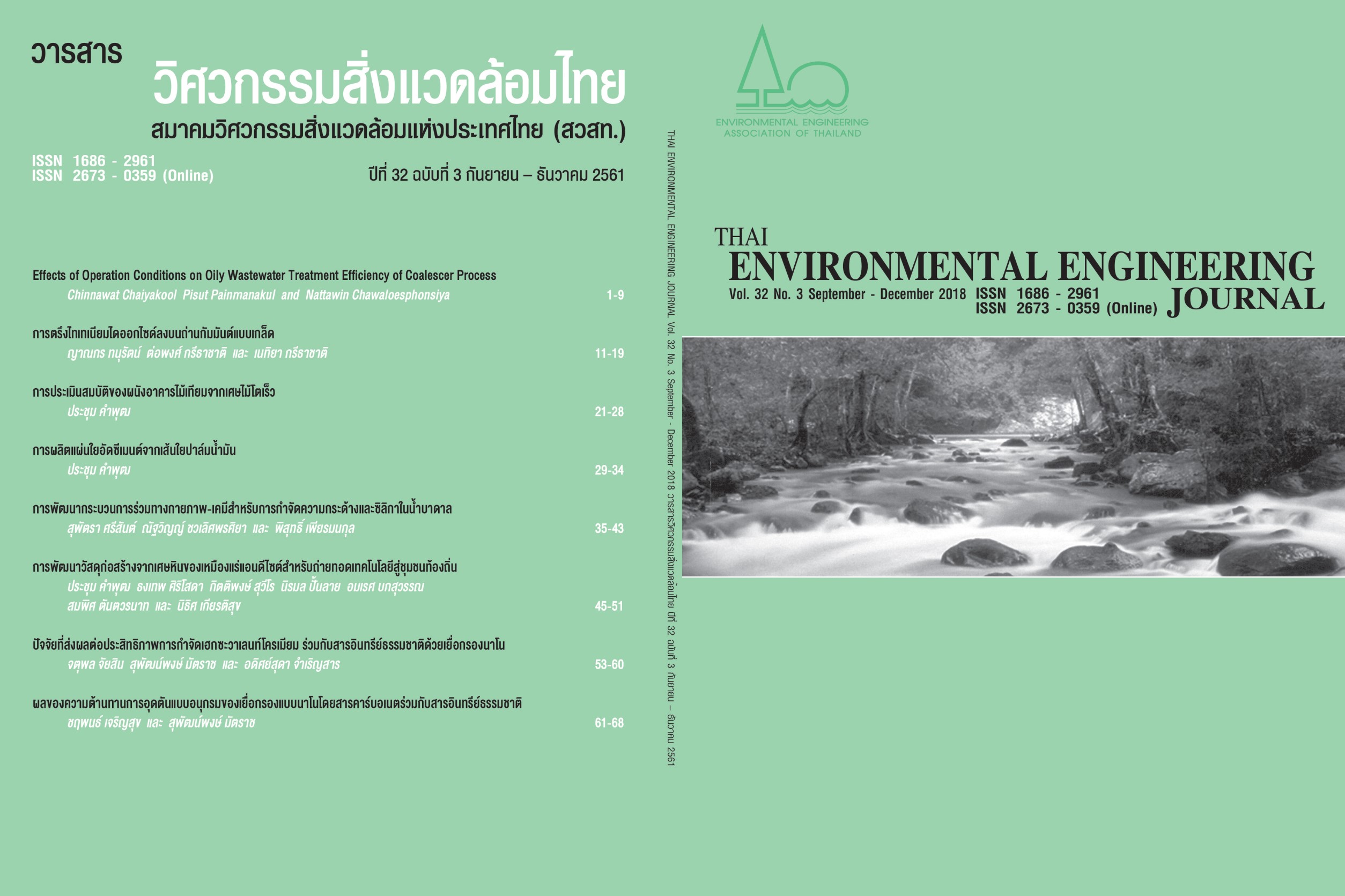Factors Affecting Hexavalent Chromium and Natural organic matter Removal by Nanofiltration Membrane
Main Article Content
Abstract
This objective of this research was to study is to investigate several factors affecting the removal efficiency of hexavalent chromium from synthetic wastewater and natural organic matter (NOM) by a dead-end nanofiltration membrane under controlled conditions. Different factors were the concentrations of hexavalent chromium derived from synthetic wastewater, natural organic matter (NOM) concentration, pH solution, mixed solution’s speed, and controlled pressure. Experimental results found that increased concentrations of hexavalent chromium from synthetic wastewater caused more fouling on nanofiltration membrane surface, thus enhancing flux decline and decreasing chromium rejection. Hexavalent chromiums from synthetic wastewater containing NOM showed greater flux decline than those without NOM. Increased pH solution from 3 to 10 resulted in greater flux decline and hexavalent chromium removal. Increased mixed solution’s speeds from 0 to 400 rpm decreased flux decline caused by a reduced solution accumulation on NF membrane surface. Increased operating pressures caused a reduction in chromium rejection. This was attributed to high operating pressure allowing hexavalent chromium passing through membrane surface. Increased NOM concentration resulted in increased hexavalent chromium rejection due to the combination between NOM and hexavalent chromium separated from NF membrane surface.
Article Details
References
[2] Jaiyong, S., Ajsakorn, O. and Rimwatthana, A. 2540. Absorption of Hexavalent Chromium by Chlorella sp. Bachelor Thesis of Science. Faculty of Industrial Education King Mongkut's Institute of Technology Ladkrabang. (in Thai)
[3] Kilduff, J.E., Mattaraj, S. and Belfort, G. Flux decline during nanofiltration of naturally occurring dissolved organic matter: effect of osmotic pressure, membrane ermeability, and cake formation. J. Membr. Sci. 239(1): 39-53.
[4] Conlon, W. and McClellan, S. 1989. Membrane Softening: A Treatment Process Comes of Age. Journal AWWA. 81(11): 47-51.
[5] Yildiz, E. Nuhoglu, A. Keskinler, B. Akay, G. and Farizoglu, B. 2003. Water softening in a crossflow membrane reactor. Desalination. 159(2): 139-152.
[6] Bruggen, Bart Van der and Carlo Vandecasteele. 2003. Removal of pollutants from surface water and groundwater by nanofiltration: overview of possible applications in the drinking water industry. Environ. Pollut. 122: 435-44.
[7] Conteras, A.E., Albert Kimb and Qilin lia. 2009. Combined fouling of nanofiltration membranes: Mechanisms and effect of organic matter. J. Membr. Sci. 327: 87-95.
[8] Tu, S., Varadarajan, R. and Massoud, P. 2005. A pore diffusion transport model for forecasting the performance of membrane processes. J. Membr. Sci. 265: 29-50.
[9] Vrouwenvelder, J.S., Kappelhof, J.W.N.M., Heijrnan, S.G.J., Schippers, J.C., van der Kooija D. 2003. Tools for fouling diagnosis of NF and RO membranes and assessment of the fouling potential of feed water. Desalination. 157: 361-365.
[10] Kilduff, J. E., Mattaraj, S., Pieracci, J. P. and Belfort, G. 2000. Photochemical modification of polyether sulfone and sulfonated polysulfone nanofiltration membranes for control of fouling by natural organic matter. Desalination. 132: 133-142.
[11] Cho, J., Amy, G. and Pellegrino, J. 2000. Membrane Filtration of Natural Organic Matter: Comparison of flux decline, NOM rejection, and foulants during filtration with three UF membranes. Desalination. 127: 283-298.


